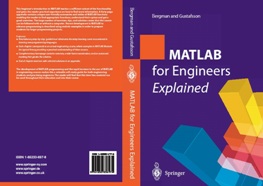
Matlab for Engineers Explained
Fredrik Gustafsson, and Niclas Bergman
Springer, 2003
Reviews:
This book has a rather unique style... it's broken into 27
mini-lectures split across three main 'topics': Learning Matlab,
Advanced Programming, and Applications. Each mini-lecture constitutes
a some 2-10 or so pages where they describe a particular problem and
its solution on the left side of the page and list the Matlab code to
solve that problem on the right hand side. They don't usually give
much motivation for _why_ you might actually care about that
particular problem, but if it's not reasonably self-evident (as in the
case of the Learning/Advanced Matlab), most of the solutions are so
compelling that it opens your eyes to ways to solves other problems
that you might have never thought of before. Note that the authors
assume that, for any given problem, you already have a grasp of the
concepts involved. I.e., when they discuss eigenvalues and
eigenvectors, the emphasis is on their use to solve a problem, but
they assume you already know the definition of the 'pieces.' The
applications are usually at the level of an advanced undergraduate or
graduate level curriculum (i.e., they are not trivial). What you get
is a TREMENDOUS amount of information in 218 pages. It's not trying in
any way to be a complete reference to Matlab, but instead is trying to
get you just enough information about lots of very different aspects
of programming and applications that you'll have no problem filling in
the details for yourself. Hence, I wouldn't recommend it for
beginners, but if you've already played with some other math package
(or Matlab itself) and have an idea as to the basics, you can become a
much more proficient 'power user' with this book.
At the end of many mini-lectures, there are various 'exercises' for
the ready to complete. Happily, the solutions are included in the back
of the book! In the applications section, the exercises are not always
particularly Matlab related but instead are intended to get you to
solidify your understanding of, say, SVD so that you don't just trust
the tool blindly. As the exercises form a valuable type of feedback,
it makes the book quite usable for self-instruction.
I don't think there's such a thing as a 'perfect' book that tries to
address so many topics while keeping the page count reasonable, so
while I can't give this particular attempt 5 stars, it's as good as
any other I've seen and the price is quite reasonable for what you
get.
**** (4/5 rating) Joel Kolstad (Portland, OR USA) at amazon.com
Contact the authors:
Fredrik Gustafsson